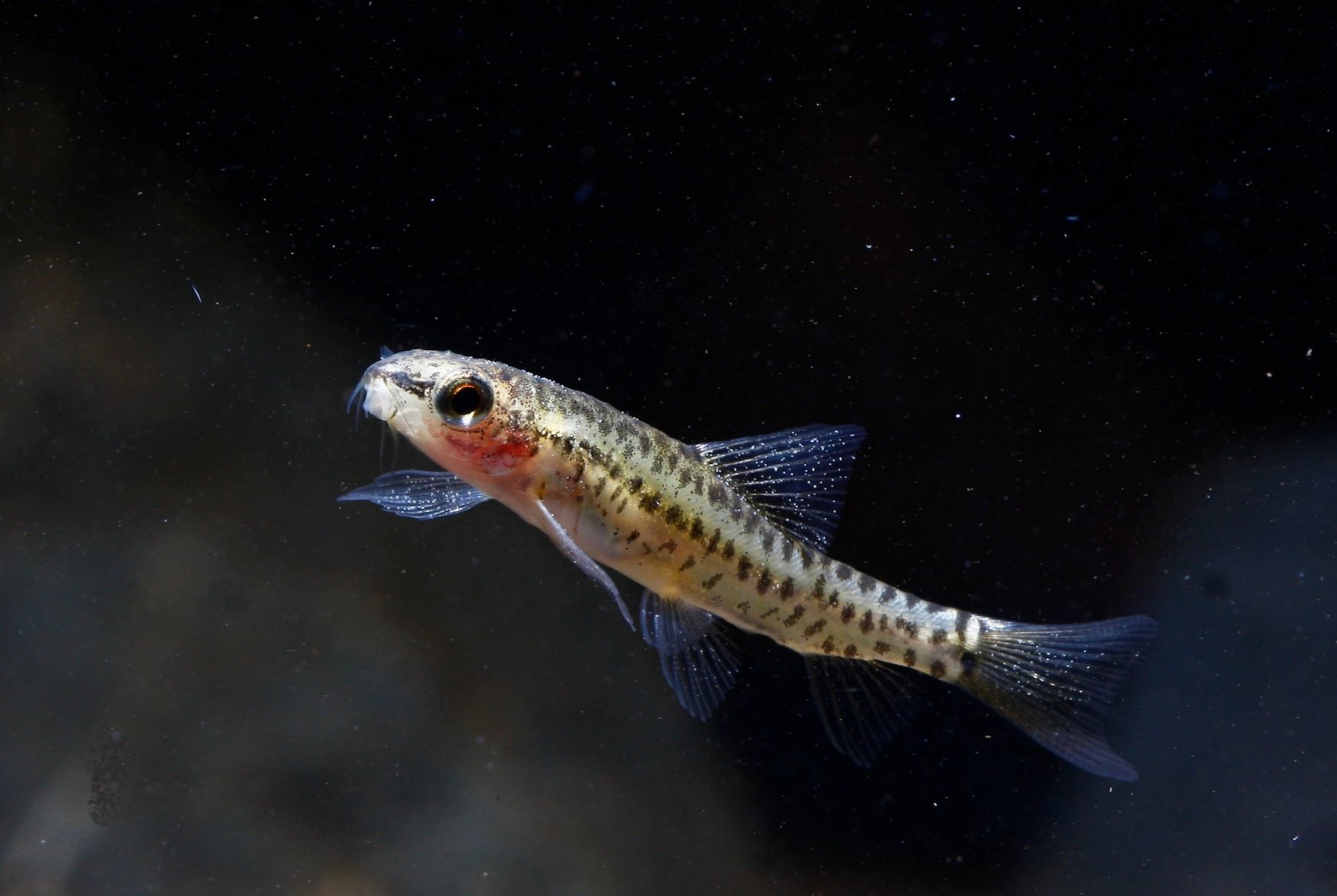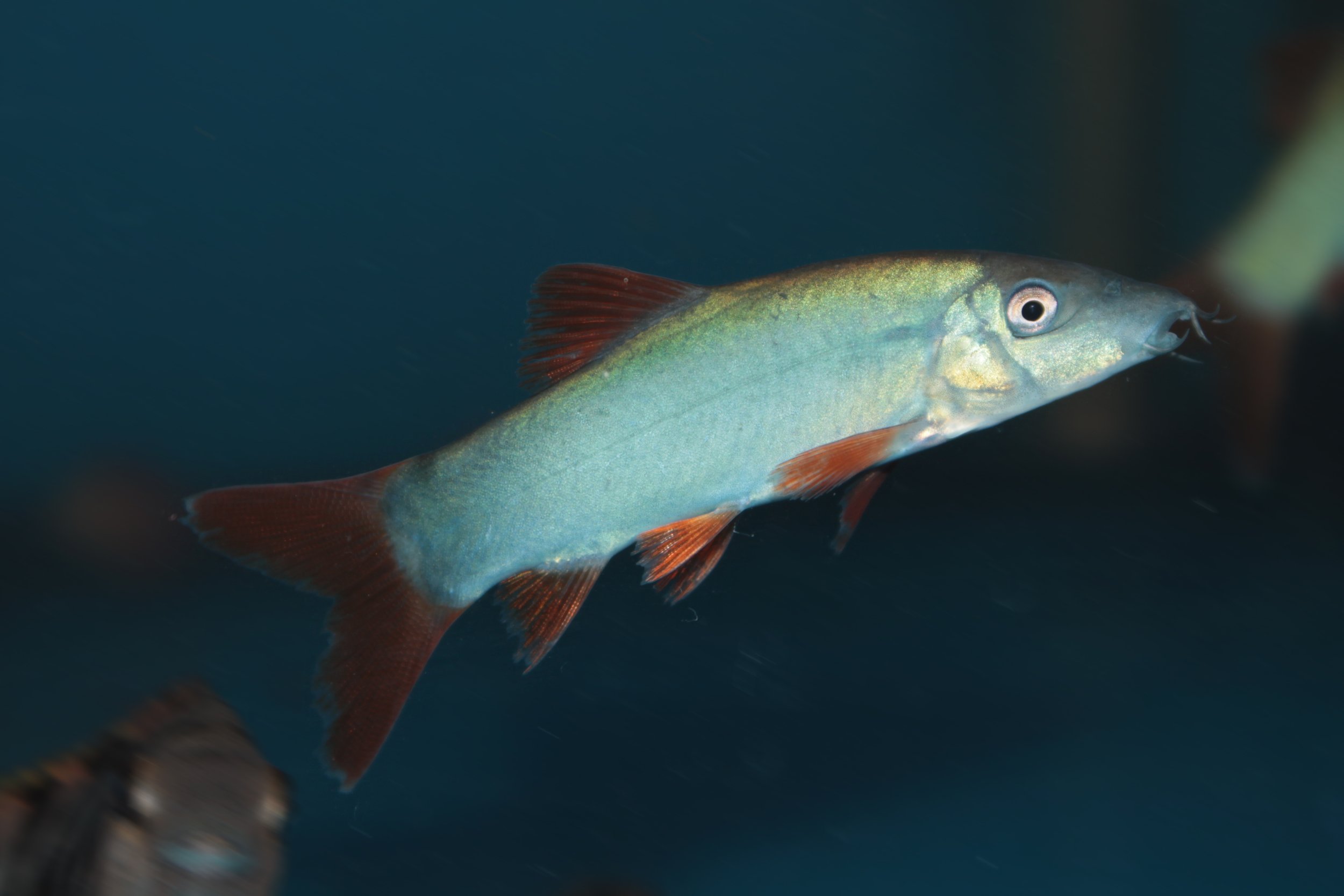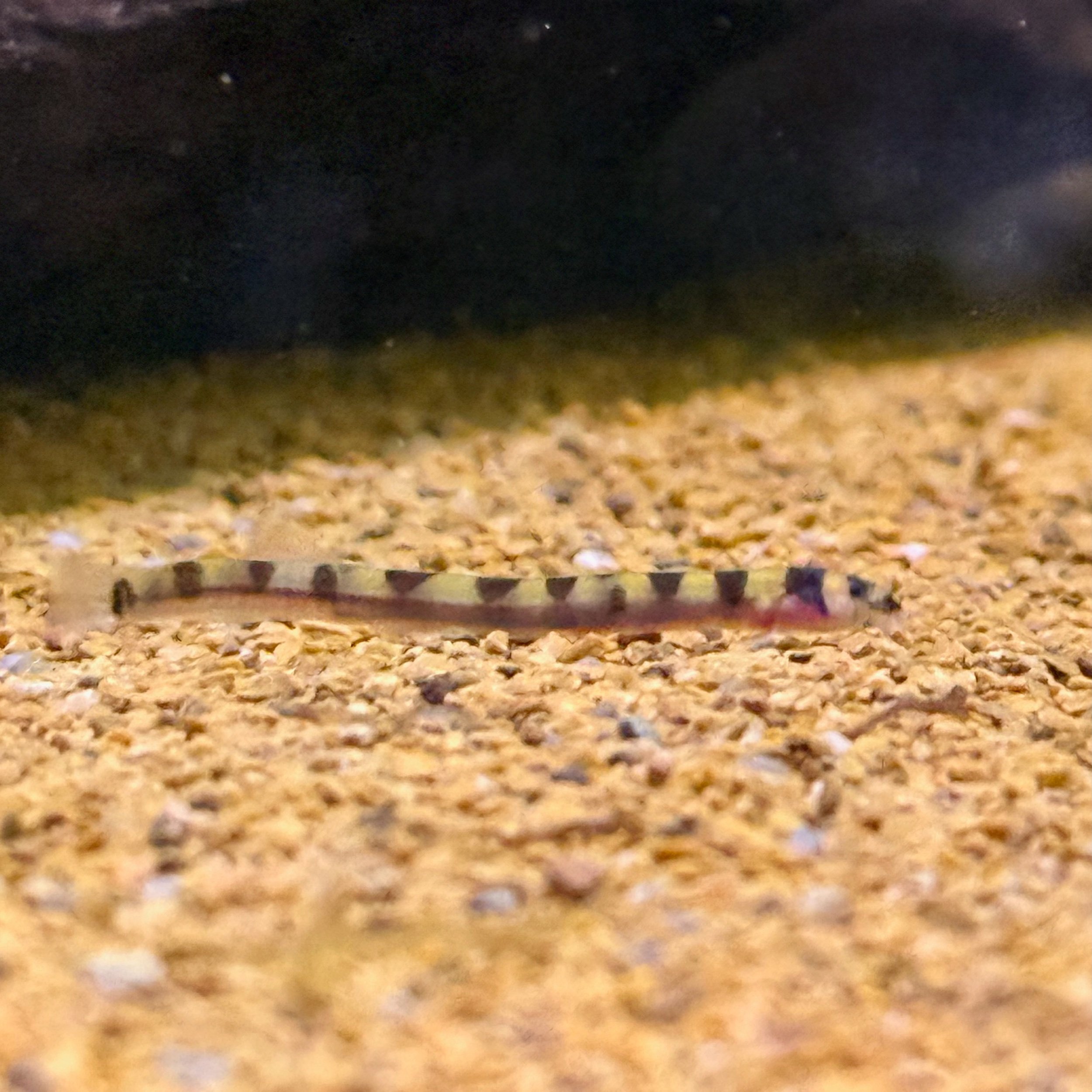 Image 1 of
Image 1 of


Rosy Loach
The Rosy Loach, scientifically known as Petruichthys sp. “Rosy”, is a small and colorful freshwater fish native to the slow-moving streams and rivers of Myanmar. This charming species has gained popularity in the aquarium hobby due to its vibrant coloration, active behavior, and peaceful temperament. Its compact size makes it a perfect candidate for nano aquariums or community tanks with other small fish.
Physically, the Rosy Loach is characterized by its elongated body, which displays a soft pink to rosy hue, with some individuals showing subtle iridescence or darker horizontal stripes. Males are more vividly colored, especially during breeding conditions, while females are slightly larger and have a more subdued coloration. These loaches typically grow to about 1 inch (2.5 centimeters) in length, making them one of the smallest loach species in the hobby.
In the aquarium, Rosy Loaches thrive in groups of at least six individuals, as they are highly social and exhibit natural schooling behaviors when kept in shoals. A tank of at least 10 gallons is sufficient for a small group, though larger tanks allow for more dynamic activity. A soft, sandy substrate is recommended to protect their sensitive barbels, along with live plants, driftwood, and rocks to provide hiding spots and replicate their natural habitat.
Water parameters for Rosy Loaches should closely mimic their native environment. They prefer slightly acidic to neutral water with a pH range of 6.0 to 7.5 and temperatures between 70 to 78°F (21 to 26°C). Clean, well-oxygenated water is crucial, so regular water changes and efficient filtration are essential to maintain their health.
Feeding Rosy Loaches is straightforward, as they are omnivores and readily accept a variety of foods. They thrive on high-quality sinking micro-pellets or wafers, supplemented with live or frozen foods like daphnia, bloodworms, and brine shrimp. They may also forage on biofilm or algae in the tank, though supplemental feeding ensures proper nutrition.
Rosy Loaches are peaceful and make excellent tank mates for other small, non-aggressive species, such as rasboras, tetras, or dwarf gouramis. They also pair well with shrimp and snails, making them a versatile addition to planted or biotope tanks. Avoid housing them with larger or aggressive species that may intimidate or prey on them.
Breeding Rosy Loaches in captivity is achievable with the right conditions. Spawning often occurs in densely planted tanks, where the females scatter their eggs among the plants or substrate. Providing a separate breeding tank with fine-leaved plants or spawning mops can increase success rates. The eggs hatch in 2 to 3 days, and the fry become free-swimming shortly afterward. The fry can be fed infusoria or finely powdered fry food before transitioning to baby brine shrimp.
Overall, the Rosy Loach (Petruichthys sp. “Rosy”) is a delightful and low-maintenance species that adds vibrant color and activity to any freshwater aquarium. Its peaceful nature, small size, and adaptability make it a popular choice for nano tanks and community setups alike. With proper care, these charming loaches will thrive and bring life to any aquascape.
The Rosy Loach, scientifically known as Petruichthys sp. “Rosy”, is a small and colorful freshwater fish native to the slow-moving streams and rivers of Myanmar. This charming species has gained popularity in the aquarium hobby due to its vibrant coloration, active behavior, and peaceful temperament. Its compact size makes it a perfect candidate for nano aquariums or community tanks with other small fish.
Physically, the Rosy Loach is characterized by its elongated body, which displays a soft pink to rosy hue, with some individuals showing subtle iridescence or darker horizontal stripes. Males are more vividly colored, especially during breeding conditions, while females are slightly larger and have a more subdued coloration. These loaches typically grow to about 1 inch (2.5 centimeters) in length, making them one of the smallest loach species in the hobby.
In the aquarium, Rosy Loaches thrive in groups of at least six individuals, as they are highly social and exhibit natural schooling behaviors when kept in shoals. A tank of at least 10 gallons is sufficient for a small group, though larger tanks allow for more dynamic activity. A soft, sandy substrate is recommended to protect their sensitive barbels, along with live plants, driftwood, and rocks to provide hiding spots and replicate their natural habitat.
Water parameters for Rosy Loaches should closely mimic their native environment. They prefer slightly acidic to neutral water with a pH range of 6.0 to 7.5 and temperatures between 70 to 78°F (21 to 26°C). Clean, well-oxygenated water is crucial, so regular water changes and efficient filtration are essential to maintain their health.
Feeding Rosy Loaches is straightforward, as they are omnivores and readily accept a variety of foods. They thrive on high-quality sinking micro-pellets or wafers, supplemented with live or frozen foods like daphnia, bloodworms, and brine shrimp. They may also forage on biofilm or algae in the tank, though supplemental feeding ensures proper nutrition.
Rosy Loaches are peaceful and make excellent tank mates for other small, non-aggressive species, such as rasboras, tetras, or dwarf gouramis. They also pair well with shrimp and snails, making them a versatile addition to planted or biotope tanks. Avoid housing them with larger or aggressive species that may intimidate or prey on them.
Breeding Rosy Loaches in captivity is achievable with the right conditions. Spawning often occurs in densely planted tanks, where the females scatter their eggs among the plants or substrate. Providing a separate breeding tank with fine-leaved plants or spawning mops can increase success rates. The eggs hatch in 2 to 3 days, and the fry become free-swimming shortly afterward. The fry can be fed infusoria or finely powdered fry food before transitioning to baby brine shrimp.
Overall, the Rosy Loach (Petruichthys sp. “Rosy”) is a delightful and low-maintenance species that adds vibrant color and activity to any freshwater aquarium. Its peaceful nature, small size, and adaptability make it a popular choice for nano tanks and community setups alike. With proper care, these charming loaches will thrive and bring life to any aquascape.
The Rosy Loach, scientifically known as Petruichthys sp. “Rosy”, is a small and colorful freshwater fish native to the slow-moving streams and rivers of Myanmar. This charming species has gained popularity in the aquarium hobby due to its vibrant coloration, active behavior, and peaceful temperament. Its compact size makes it a perfect candidate for nano aquariums or community tanks with other small fish.
Physically, the Rosy Loach is characterized by its elongated body, which displays a soft pink to rosy hue, with some individuals showing subtle iridescence or darker horizontal stripes. Males are more vividly colored, especially during breeding conditions, while females are slightly larger and have a more subdued coloration. These loaches typically grow to about 1 inch (2.5 centimeters) in length, making them one of the smallest loach species in the hobby.
In the aquarium, Rosy Loaches thrive in groups of at least six individuals, as they are highly social and exhibit natural schooling behaviors when kept in shoals. A tank of at least 10 gallons is sufficient for a small group, though larger tanks allow for more dynamic activity. A soft, sandy substrate is recommended to protect their sensitive barbels, along with live plants, driftwood, and rocks to provide hiding spots and replicate their natural habitat.
Water parameters for Rosy Loaches should closely mimic their native environment. They prefer slightly acidic to neutral water with a pH range of 6.0 to 7.5 and temperatures between 70 to 78°F (21 to 26°C). Clean, well-oxygenated water is crucial, so regular water changes and efficient filtration are essential to maintain their health.
Feeding Rosy Loaches is straightforward, as they are omnivores and readily accept a variety of foods. They thrive on high-quality sinking micro-pellets or wafers, supplemented with live or frozen foods like daphnia, bloodworms, and brine shrimp. They may also forage on biofilm or algae in the tank, though supplemental feeding ensures proper nutrition.
Rosy Loaches are peaceful and make excellent tank mates for other small, non-aggressive species, such as rasboras, tetras, or dwarf gouramis. They also pair well with shrimp and snails, making them a versatile addition to planted or biotope tanks. Avoid housing them with larger or aggressive species that may intimidate or prey on them.
Breeding Rosy Loaches in captivity is achievable with the right conditions. Spawning often occurs in densely planted tanks, where the females scatter their eggs among the plants or substrate. Providing a separate breeding tank with fine-leaved plants or spawning mops can increase success rates. The eggs hatch in 2 to 3 days, and the fry become free-swimming shortly afterward. The fry can be fed infusoria or finely powdered fry food before transitioning to baby brine shrimp.
Overall, the Rosy Loach (Petruichthys sp. “Rosy”) is a delightful and low-maintenance species that adds vibrant color and activity to any freshwater aquarium. Its peaceful nature, small size, and adaptability make it a popular choice for nano tanks and community setups alike. With proper care, these charming loaches will thrive and bring life to any aquascape.








